Morgan Advanced Materials has introduced a new yellow glaze (GSY) for ceramic reflectors that improves efficiency of laser systems by filtering out UV and low wavelengths in laser pumping cavities. This reduces the overall temperature of the laser system and increases its life. It is suited to industrial lasers used in manufacturing and as a result end users can benefit from a reduced cost of ownership.
The visible yellow colour of the glaze is complementary to the spectral colours violet and indigo and effectively absorbs low wavelengths up to approximately 450nm. This means the laser cavities do not reach the high temperatures seen previously and consequently require less cooling fluid. This gives a further benefit that the pumps do not have to work as hard as before.

Overall this leads to increased reliability of the laser system and an extended lifespan. For a like for like design, using the GSY glaze improves output by 5 Watts, which is approximately nine per cent higher than with a clear glaze.
The yellow glaze is available as an alternative option to the company's highly reflective clear glaze (GSO). Both seal ceramic reflectors against the ingress of cooling fluids that may alter the refractive index, introduce impurities and reduce reflectance and operating efficiency.
"The new glaze has been designed in such a way that it absorbs all wavelengths up to 450nm," says Yannick Galais, commercial manager MTC Rugby. "We work with many leading laser manufacturers in Europe, USA and Asia and by introducing the new glaze we will be able to improve the output, reliability and life of their systems, as well as helping them to save money through using less cooling fluid."
The company has made significant advances in designing ceramic components and reflectors for lasers over the last 30 years. Morgan Advanced Materials' robust laser reflectors are produced from a high performance alumina-based ceramic. They have high strength, good thermal conductivity and excellent dimensional and electrical stability at all operating temperatures. They are resistant to chemical attack and have a high reflectivity over a broad wavelength band.
Ceramic reflectors are a cost effective alternative to metal coated reflectors and the new glaze further reduces the cost of ownership.